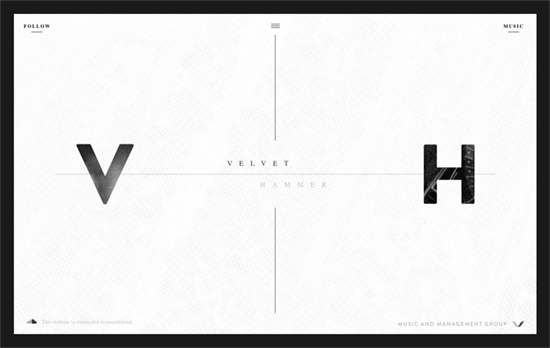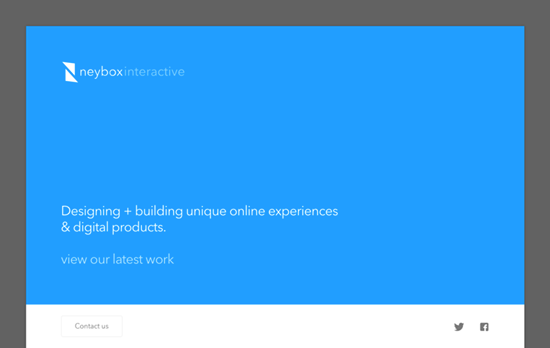Get a shot of energy by looking at these websites with background animations. How do you tow the line between eye-catching and too-distracting movement? Let’s see: [Read more…]
Search Results for: plugins
7 WordPress Hacks to Speed Up Your Site
WordPress is an amazing platform that allows you to make your own website. For this, there are plenty of online resources that can guide you every step of the way. However, not all of them are tailored towards building a speedy site. [Read more…]
Design Focus: Site Frames
Designs of the Week
Get solid WordPress themes, plugins, and even design training from iThemes.

There’s a nice mix between a modern feel and subtle grunge touches here, which sort of represents both the music management and artist aspects to their company. The page scrolls inside the box and there are three menus which overlay on the area once clicked: social media, music, and the main menu.

A clean, simple, predominantly black-and-white site with a boxy, bento-style layout.

Nice bright colors marking each section and product of the homepage. The large imagery and small descriptions are a familiar pattern in websites these days, but the fact that the layout doesn’t span the entire width of the browser instantly makes it look different from the rest that’s out there, not to mention the treatment of the above-the-fold block.
Social Media Weekly
Search Optimized, Turn-Key Designs, Unlimited Everything. Start building with the Genesis Framework today.
CSS – Ways You Need To Tell The Browser How To Optimize
“Rather than the presumed “browsers will get faster at running my code”, there is a little more “I need to change the way I code for browsers to get faster.””
Typopgraphy – glyphdiff
“Glyphdiff is a simple tool comparing the differences of two fonts on given glyphs.”
JavaScript – JavaScript for Designers
“Rather than sit, and try to digest boring definitions, we’ll dive right into building an interactive HTML prototype, and have fun learning JS together along the way.”
10 Future Web Design Trends to Grab Right Now
Every December, you can expect to see a list of web design trends that gives designers an idea of what to expect in the coming year. But what if you want to plan further ahead than that?
Lucky for you, we’ve compiled a list of predictions that will help you prepare for the longer term. [Read more…]
Designed For Safety: Building A Secure WordPress For Ecommerce
In many ways, WordPress is infinitely flexible – if you want to do something, surely there’s a plugin available that will help. But if you’re conducting ecommerce through your WordPress, it’s important that you take further steps to protect your users. Your site will need to be secure through and through.
Luckily, with web safety becoming an increasing concern, there are a number of ways to both improve the security of your ecommerce practices and alert your customers to these improvements. Here are a few security strategies that work especially well with WordPress.
Excellent Encryption
If you’re conducting ecommerce on a WordPress site, you’ll need to make sure any information that passes through your payment system is well encrypted. The new standard is 2048 bit encryption – with some authorization groups refusing to even work with sites still using 1024 bit encryption. Check with your chosen payment gateway to ensure this level of encryption is being met.
Upgrade Uptake
WordPress’s plugins are great, making the site really accessible to beginners. The more complex parts are already done in most cases. But the other thing about using plugins is that they still require oversight, even if you don’t really understand how they work. You can’t just leave them for months or years untouched.
Though you’ll need to take a look at some code to run a great WordPress, you don’t need to learn coding languages from start to finish. But when it comes to plugins, you do need to make sure you’re using secure plugins and that you always install updates as soon as they’re issued. Updates are developed in response to issues like security breaches, so stay in compliance by staying up to date.
Skip The Storage
One of the easiest ways to reduce liability for both yourself and your customers is by setting up your ecommerce system without any credit card information storage. While some customers will find this inconvenient – they can’t just pull up their account and make a purchase like they might on Amazon – by not storing their data, there’s nothing left for fraudsters to steal.
Do be careful to save enough information to handle any chargebacks or refunds, but make sure you purge your records on a regular basis. Have a clear policy regarding how long customers have to request a refund and toss the information after that.
Show Your Certifications
Once you have a WordPress domain, make sure you’re a certified secure site. An SSL certificate is a highly visible way to mark your ecommerce setup as safe for exchanges. You may not have realized the relevance of these marks before, but links with a green seal – that use an https protocol – are showing that they use a secure connection. Show your colors by earning that green seal.
Understand Risk Assessment
No matter what systems you have in place to protect your ecommerce practices, it’s important that you have a risk assessment protocol in place. Even if your business is small and you trust WordPress as a host, things can go awry. Regularly check your code, install updates, and make sure your site is in compliance with any new security protocols. Risk assessment isn’t just for doctors or big businesses – it’s an important step for anyone handling secure information.
WordPress offers great tools for small businesses and organizations, and it has a strong reputation for safety and reliability. As a site owner, however, you’re responsible for maintaining that reputation for the sake of your customers. Keep these strategies in mind and keep your customers’ information safe.
5 of the Most Effective WordPress Security Tips on the Internet
